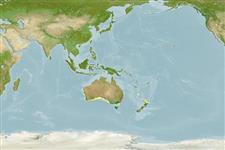分類 / Names
俗名 | 同種異名 | Catalog of Fishes(屬, 種) | ITIS | CoL | WoRMS | Cloffa
Teleostei >
Gobiesociformes (Clingfishes)
喉盤魚目 (Clingfishes) >
Gobiesocidae (Clingfishes and singleslits)
喉盤魚科 (Clingfishes and singleslits) > Cheilobranchinae
Etymology: Cochleoceps: Greek, kochlea = snail like + Latin, ceps, caput = head (Ref. 45335).
Environment: milieu / climate zone / depth range / distribution range
生態學
海洋 居於水底的; 深度上下限 3 - 40 m (Ref. 9002). 亞熱帶的
Southwest Pacific: New South Wales and eastern Victoria, Australia.
西南太平洋: 新南威爾斯與東方的澳洲維多利亞省。
大小 / 重量 / 年齡
Maturity: Lm ? range ? - ? cm
Max length : 5.5 cm TL 雄魚/尚未辨別雌雄; (Ref. 9002)
簡短描述
型態特徵 | 形態測量圖
背棘 (總數): 0; 背的軟條 (總數): 5-6; 臀棘 0; 臀鰭軟條: 4 - 6. Caudal fin rounded (Ref. 9002). Pelvic fins united into moderate-sized double sucking-disc, posterior half with a fleshy fringe (Ref. 9002). Greenish-yellow to orange with small scattered dark spots to larger red spots, variable in density; iridescent blue dashes or lines dorsally and across sides over head and body (Ref. 9002).
尾鰭圓的。 (參考文獻 9002) 腹鰭結合成中等大小的雙吸盤了, 後半段具有一個肉質的穗邊。 (參考文獻 9002) 黃綠色的到橘色的有小對比較大的紅色斑點的分散深色的斑點, 可變的在密度; 藍色虹彩的破折線或線背面與越過在頭部與身體上的側邊.(參考文獻 9002)
Adults usually on kelp, on which they deposit their eggs, which are guarded by the male, although the female is often present as well (Ref. 9002). Often on ascidians or sponges in deep water, probably depositing eggs on algae nearby (Ref. 9002). Often observed cleaning boxfishes, porcupine fishes and morwongs (Ref. 9002).
成魚通常在海藻上, 藉著它他們堆積他們的卵,那是由雄魚保衛, 雖然母魚時常呈現成得好.(參考文獻 9002) 時常在海鞘類或海綿上在深水中, 可能在附近堆積卵吃藻類.(參考文獻 9002) 時常觀察清潔箱魨,二齒魨魚與 morwongs 。 (參考文獻 9002)
Life cycle and mating behavior
成熟度 | 繁殖 | 產卵場 | 卵 | 孕卵數 | 仔魚
西南太平洋: 新南威爾斯與東方的澳洲維多利亞省。
Kuiter, R.H., 1993. Coastal fishes of south-eastern Australia. University of Hawaii Press. Honolulu, Hawaii. 437 p. (Ref. 9002)
人類使用
更多資訊
俗名同種異名新陳代謝捕食者生態毒物學繁殖成熟度產卵場產卵群集孕卵數卵卵發育
年龄/大小成長長度-重量長度-長度長度-頻率形態測量圖型態特徵仔魚稚魚動力學入添量豐度BRUVS
參考文獻養殖養殖資訊品種遺傳學Electrophoreses遺傳率疾病加工NutrientsMass conversion
合作者照片Stamps, Coins Misc.聲音神經毒速度泳型鰓區Otoliths腦重體重比眼睛色素
工具
特別的報告
下載 XML
網路資源
Estimates based on models
Preferred temperature (Ref.
123201): 16.4 - 23.3, mean 18.2 °C (based on 72 cells).
Phylogenetic diversity index (Ref.
82804): PD
50 = 0.5312 [Uniqueness, from 0.5 = low to 2.0 = high].
Bayesian length-weight: a=0.00389 (0.00180 - 0.00842), b=3.12 (2.94 - 3.30), in cm total length, based on all LWR estimates for this body shape (Ref.
93245).
營養階層 (Ref.
69278): 3.2 ±0.3 se; based on size and trophs of closest relatives
回復力 (Ref.
120179): 高度, 族群倍增時間少於 15個月 (Preliminary K or Fecundity.).
Fishing Vulnerability (Ref.
59153): Low vulnerability (10 of 100).
Nutrients (Ref.
124155): Calcium = 282 [138, 664] mg/100g; Iron = 1.45 [0.79, 2.77] mg/100g; Protein = 17.3 [16.2, 18.5] %; Omega3 = 0.332 [0.174, 0.648] g/100g; Selenium = 14.9 [6.4, 39.9] μg/100g; VitaminA = 47.7 [12.5, 172.0] μg/100g; Zinc = 1.53 [0.98, 2.36] mg/100g (wet weight);
